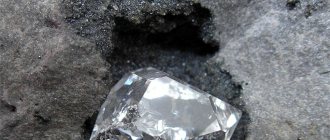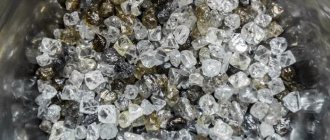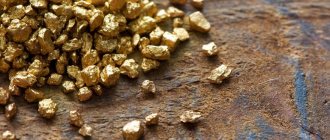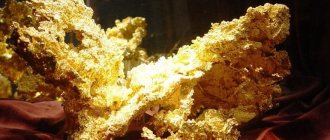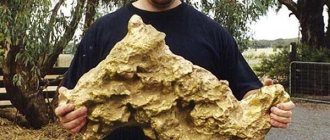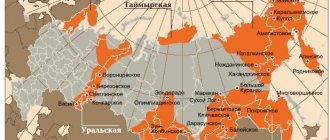Even in ancient times, gold was valued as the most expensive metal. People are still interested in how gold deposits can be discovered.
But to do this, you need to know in what form this precious metal is found in nature. Deposits with precious metal reserves may vary depending on the method of formation and the place where the metal was formed. Thus, they are divided into primary (root) and secondary (placers).
Bedrock deposits
Such formations of gold appeared as a result of the movement of magma during a period of volcanic activity. Magma contains much more of this metal than the earth's crust.
Magma, escaping from the depths, gradually solidified, as a result of which minerals were formed. If the elements had increased refractoriness, they crystallized, and low-melting substances moved on. But not only gold has a low melting threshold; there were also other elements, the combination of which formed a chemical complex of substances. Therefore, in the area of primary deposits it is difficult to find gold in its pure form. Typically, compounds where there are gold inclusions consist of a combination of iron, copper, lead and zinc.
Because As a result of volcanic activity, mountains were formed, then gold must be looked for in mountainous gold-bearing areas.
Goldstrike, USA
Goldstrike and Cortez actually tied for 6th place in terms of production in 2014. Since production is decreasing at Cortez, it is reasonable to assume that Goldstrike produced more in 2015. The Goldstrike Mine is located northwest of the Carlin Mine off the Carlin Trend.
Goldstrike also owns , which acquired the mine in 1987. Before this, the mine belonged to PanCana, which operated it as a joint venture since 1978.
The mine consists of three deposits. One of them is the Betze-Post open-pit mine. The remaining mines are Meikle and Rodeo, which are underground.
✰ ✰ ✰
5
Placer deposits
Secondary type gold reserves arose in the process of various mechanical and chemical impacts on primary type gold deposits.
Gold particles moved from mountainous areas to plains as a result of the following natural phenomena:
- Groundwater movements.
- Wind.
- Rock falls, etc.
Rains and mountain rivers carried mountain rocks closer to their foot. When colliding with boulders and other magma formations, they were crushed, displacing gold particles. Gold is inert in relation to other chemical units, so it settled in its pure form in various bodies of water (rivers, lakes, etc.).
Although the source of gold is the same, there is a significant difference between placer gold deposits and bedrock deposits.
Over millions of years of formation of the earth's surface, it is almost impossible to track the migration of gold deposits.
There are fewer primary placer deposits, but it is easier to detect their locations, because they are visible on the surface. At the same time, they are easier to develop, while searching for and extracting mine gold is a much more labor-intensive process.
Where does gold come from?
Contrary to the belief of most people that gold is very rare in nature, it is one of the most common metals on our planet. It is found not only in minerals, but also in plants, animal organisms and even in water.
Thus, the human body contains about 10 mg of gold, and 1 ton of ocean water contains from 4 to 10 mg, i.e. More than 10 billion tons of this noble metal are dissolved in the depths of the world's oceans. Another thing is that humanity does not yet have the technology to establish profitable extraction of the yellow metal from ocean water. Therefore, for now the only opportunity to extract it on an industrial scale is the development of gold deposits.
Today, scientists do not have a consensus on how gold appeared on Earth: perhaps it was brought by meteorites that fell on the planet, or maybe it was already in the proto-matter from which the globe was formed. But despite the uncertainty about the origin, the mechanism of the appearance of gold on the surface has been studied in sufficient detail. There are 2 types of gold deposits: primary and placer. Indigenous are considered primary, since their appearance is directly related to magmatic processes that continuously occur in the earth’s crust.
It is known that inside the earth almost all metals are in a molten state. The magma that breaks out to the surface under high pressure passes through faults and cracks in the surface layers of the earth's crust, filling them, and cools over time. But since it is heterogeneous in composition, cooling occurs unevenly.
The most refractory substances crystallize first, and then this process proceeds in a descending manner: the less refractory a metal has, the later it crystallizes. Salt solutions containing gold were among the last to cool in this process.
Placer deposits are considered secondary because they appeared as a result of prolonged exposure to weather on primary deposits. Under the influence of wind, rain, heat, etc. the latter crumble, and the noble metal they contain falls into the soil mainly in the form of gold grains and much less often in the form of gold nuggets.
Properties and Application
The density of gold is 19.3 g/cm³, the metal melts at a temperature of +1063°C, and the boiling point reaches +2660°C. It is very malleable and plastic. Conducts heat and electric current well. Only silver and copper are superior to gold in this case.
This precious metal is a chemically resistant element. Even if it is heated strongly in air, it will not change its shape. This substance can only be dissolved in aqua regia, chlorine water or solutions of alkali metal cyanides. Mercury can also dissolve gold, forming an amalgam. If the latter contains more than 15% precious metal, then it becomes hard.
To this day, the most expensive jewelry is made from this precious metal, and it is a measure of value.
Because of its softness, gold is often combined with copper or silver. To find out how much gold is contained in the alloy, just look at the sample of the product; it indicates how much of the precious metal is per 1000 g of the alloy. Two samples are accepted as a standard - 583 and 750. Countries involved in gold mining are often among the most developed countries.
Grasberg, Indonesia
Grasberg in Indonesia has long been the world's leading gold mine. It is still touted as the largest mine in the world, and the third largest copper mine. Currently, Grasberg is an open pit mine, but by the end of 2021, production will move to the underground part of the deposit. In 2014, Grasberg produced 1.1 million ounces of gold.
The owner of the field is Freeport-McMoRan, which owns 90.64% of the shares. The company has 19,500 employees. The Indonesian government owns the remaining 9.36% of the mine. Grasberg is located near Mount Jaya in Indonesian New Guinea. Jaya is the highest mountain in Papua, and therefore extraction of rocks is a particularly labor-intensive process here.
The deposit was discovered in 1936 by Dutch geologist Jean-Jacques Dozy, although it was not developed until 1960, when George Mealy (CEO of Freeport-McMoRan) and Forbes Wilson sent a special expedition to prove the value of the deposit. When Indonesia gained independence in 1963, Grasberg became the first mine opened by the Suharto government.
✰ ✰ ✰
1
The world's largest gold deposits
The largest gold deposits in the world are listed below:
- Boddington. The mines are located in Australia. Gold and copper are mined in Boddington. Gold mining began in 2009. By 2011, the first million ounces were mined.
- Lihir. The island is Aniolam, the country is Papua New Guinea. The mines have been operating since 1982. In 2010, the gold deposit was purchased by the Australian company Newcrest.
- Peñasquinto. The mine is located in the state of Zacatecas (Mexico) and is owned by Goldcorp (Canada). The quarry is considered the largest in Mexico and the fifth largest in the world.
- Carlin. The quarry is located in Nevada (USA). 75% of the country's total gold and 3% of the yellow metal mined in the entire history of gold mining are mined here. The map of gold mines in the state of Nevada is not limited to two or three deposits, there are a lot of them. Some of the largest are also the Cortez and Goldstrike deposits.
- Yanacocha. North of Peru. The largest deposit in Latin America, with an area of more than 1386 km².
- Pueblo Viejo. The quarry is located in the Dominican Republic, 100 km from the capital of the country, Santo Domingo. After attempts by the government of the Dominican Republic to organize mining of the precious metal to no avail, it was decided to grant these rights in 2012 to the Canadian companies Barrick Gold and Goldcorp.
- Grasberg. Indonesia, a country rich in volcanic rocks, is home to one of the largest gold mining operations in the world. It is there that the largest reserves of gold and the second largest reserves of copper are found.
- Muruntau. Geologists discovered this deposit in 1958 in Uzbekistan in the Kyzyl-Kum desert. The mine started operating in 1967. Turquoise and arsenic are also mined in large quantities in these places.
All these places have the largest reserves of the precious metal on the planet. Although the gold mining map is much more extensive.
Boddington, Australia
The Boddington field is located in Western Australia near the city of Perth. Mining in Boddington is carried out by open-pit mining. In 2014, 700 thousand ounces of gold were mined here. There are believed to be another 20 million ounces in reserve.
Mining at the Boddington gold mine began in 1987 through the joint efforts of Normandy Mining (44.44%), Acacia Resource (33.33%) and Newcrest Mining (22.23%). Production ceased in 2001 when known reserves of oxide ore were exhausted. Newmont bought out Newcrest Mining in 2005 and Acacia Resource in 2009, allowing the company to take a majority stake in the Boddington gold mine. Mining resumed the following year, quickly elevating Boddington to the list of top gold mines.
✰ ✰ ✰
9
Gold mining areas in Russia
As experts noted, there are more than 22,000 tons of this metal in Russian subsoil deposits. On average, 190 tons of gold are mined annually. In terms of the amount of reserves, Russian regions occupy an honorable second place. South Africa is in first place. 11% of the world's gold reserves are located in the Russian Federation. The largest gold deposit is Sukhoi Log, located near Irkutsk. The Sukhoi Log deposit contains approximately 1,900 tons of gold ore. Gold reserves in this area are developed mainly from placer mines. The Sukhoi Log deposit was discovered back in 1961. Since 2017, large companies and Polyus have begun work at the Sukhoi Log mine.
Other deposits include:
- Districts of Eastern Siberia - Yenisei, Prilensky, Bodaibinsky, East Transbaikal.
- In the Yakut region - Verkhoyansk and Aldan districts.
- North-eastern part of the country.
- Amur region.
- Primorsky Krai.
Until recently, Natalka, located in the Magadan region, was considered a large gold deposit. At the moment, work there has been temporarily stopped.
At the beginning of work, when there is still a lot of metal, mining is carried out using the quarry method; in subsequent years, as a result of depletion of reserves, they switch to the underground mining method. For example, at the Sukhoi Log deposit, open-pit gold mining is designed for 50 years.
The largest gold mines in Russia
The main active deposits of the Russian Federation are of the primary type; their development has been carried out since the times of the USSR. This list includes the following mines:
- The Berezovskoe primary deposit, mining in which has been carried out since the mid-18th century, continues to this day.
- Vorontsovsky mine, located in the Sverdlovsk region. Its development began relatively recently - in 2000. It is noteworthy that it was here that the method of heap leaching of gold at sub-zero ambient temperatures was first tested.
- Sukhoi Log is a large deposit in Eastern Siberia, characterized by significant gold reserves, but with a low content of precious metal in the ore. Currently, industrial development of subsoil is not carried out.
- The Natalka deposit is a rich mine, which is also not currently being developed.
Russia is not in first place in terms of gold reserves, however, given the huge area of unexplored territories in the North, the situation may change in the future.
You may be interested in: Where to look for gold in the Urals - map of gold-bearing rivers
World gold mining
100-150 years ago, people did not have information about the origin of the gold metal, so mining it became a gamble for them. Today, even a schoolchild will talk about the origin of gold in certain rocks, and therefore its mining has reached an industrial level. Scientists can accurately calculate how many grams of precious metal can be obtained from a particular rock.
To date, 160 thousand tons of gold have been mined, and the bulk of production has occurred in the last 100 years.
Veladero, Argentina
The Veladero mine is located in the San Juan province of Argentina, adjacent to the Pascua-Lama Project gold mine (which is also owned by Barrick Gold). The Veladero mine, according to researchers, has a reserve of 10 million ounces of gold. In 2014, 722 thousand ounces of gold were produced and an additional 622 thousand ounces were produced. With production increasing year after year, mining appears to be on the rise.
In 2007, Barrick Gold installed a wind turbine on Veladero, setting a world record for the world's tallest wind turbine at 1.28 km above sea level. The nearby Pascua-Lama Project mine covers a quarter of Argentina and three-quarters of Chile, where the mining industry has been criticized. The mines are located next to glaciers, and Chilean activists complain about the negative impact of mining on the environment.
✰ ✰ ✰
8
Leading countries in gold production
More recently, the leading positions in the production of the yellow metal were occupied by the regions of South Africa, or rather South Africa. Today everything has changed, and completely different states have emerged as leaders.
The leading positions are occupied by the following countries:
- People's Republic of China - the amount of gold mined is 455 tons.
- Australia - 270 tons.
- In Russia, 250 tons of gold were mined.
- United States of America - 209 tons.
- Canada - 170 tons.
Other countries are only slightly inferior to those mentioned above. Major gold-mining countries also include South Africa, Mexico, Uzbekistan, Indonesia, Peru, Ghana and Brazil.
But gold deposits in deposits tend to run out, and metal reserves are depleted over time (for example, the Natalka gold deposit in Russia). Therefore, in many countries, increasing attention is being paid to geological exploration of new deposits. The world's largest gold mining companies are starting mining in areas previously considered unprofitable. This leads to the fact that technologies for the extraction of this metal are constantly being improved.
Cortez, USA
In recent years, production at the Cortez deposit has decreased by 48%, due to a gradual transition to underground mining.
The Cortez gold mine is located in Nevada. The open pit and underground mining complex is located approximately 70 miles southwest of Elko. The entire complex includes the underground Cortez Hills mine as well as two open pit mines. Cortez is owned by , headquartered in Toronto, Ontario, Canada.
✰ ✰ ✰
6
Classification of gold-bearing subsoil
Gold is often discovered when exploring deposits of other metals. For this reason, many enterprises prefer to develop mixed fields to obtain double benefits . Judging by the gold reserves they contain, the primary deposits are classified as:
- unique - if their volume is more than 1000 tons;
- very large - with estimated reserves in the range of 400−1000 tons;
- large - with a potential of 100 to 400 tons;
- medium - with reserves in the range of 25-100 tons;
- small - with a maximum of 25 tons.
For secondary deposits, the production figures are much more modest: more than 50 tons for a unique one, 5−50 tons for a very large one, 1−5 tons for a large one, 05−1 tons for a medium one and less than 500 kg for a small one.
This difference in demands between bedrock and placer deposits is easy to explain. The development of secondary deposits is simpler and more economical in relation to primary ones, since the result of mining in them is almost pure gold-bearing sand. In primary deposits, in order to obtain gold, you need to process the ore. For example, if the gold content in one ton of ore does not exceed 250 mg, this can already be considered a good indicator.
To date, the level of new technologies has made it possible to significantly increase the industrial production of this precious metal. For comparison, the maximum annual production volume in the Roman Empire in the 2nd-3rd centuries was 8 tons, and today in the Russian Federation alone this figure exceeds 200 tons.
Moreover, the largest gold mining companies develop primary deposits; the development of secondary deposits accounts for only 5% of the total volume. In Russia, this figure is about 20%, which indicates outdated domestic technologies in the field of gold mining.
History of the development of gold-bearing veins
Archaeologists suggest that gold mining as a branch of the national economy originated in the Middle East. From there, jewelry was exported to Egypt. The first finds in Sumerian tombs are more than 3 thousand years old.
One of the richest cultures in gold reserves was the ancient Inca Empire, which was located in the territory of modern Mexico, Peru and Chile. Their legacy is the mythical golden city of Eldorado, in search of which the Spanish conquistadors went.
In the 15th century, the first deposits were discovered in Mexico, Chile and Ghana. Three centuries later, the first gold mining cooperatives appeared in Russia. In 1823, the richest veins were discovered in Canada and America, which was marked by the outbreak of the famous “gold rush”. Even later, deposits were discovered in South Africa and Australia.
Muruntau, Uzbekistan
In recent years, Muruntau in Uzbekistan ranks 1st in terms of production volume, overtaking Grasberg. In 2013 and 2014, the competition between them was not even close. Muruntau produced 2.52 million ounces of gold in 2013 and 2.6 million in 2014. This is a huge open pit, according to scientists, there are still about 170 million ounces of gold reserves here, so at the current level of production, the mine could be a leader within the next 60 years.
Muruntau belongs to the Navoi Mining and Metallurgical Combine, which belongs to the state of Uzbekistan. The plant was founded in 1964 as part of the gold mining enterprises of the Soviet Union. The world's largest BIOX plant has been put into operation here to combat the depletion of oxide ore reserves.
